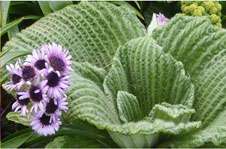Credit: University of Otago
The mystery of why so many plants on New Zealand's otherwise bleak subantarctic islands have very large deeply coloured flowers and giant leaves has been solved by new University of Otago research.
These insect-pollinated "megaherbs" stand out like sore thumbs amongst the islands' other flora which are small, wind-pollinated plants that mainly reproduce by self-pollination or asexual reproduction.
Department of Botany researchers thermally imaged six species of Campbell Island megaherbs – whose mainland relatives are small and pale flowered – and discovered that their flowers and leaves heat up rapidly to make the most of rare moments of sunshine and calm weather.
The researchers found that leaf and flower temperatures of all six species were considerably higher than simultaneously measured surrounding temperatures, with the greatest heating seen in Campbell Island daisies.
Study co-author Dr Janice Lord says these daisies and other megaherbs appear to have evolved deeply pigmented flowers and often large, thick, hairy leaves to cope with some of the most relentlessly cloudy and cool conditions in the world.
"Their dark floral pigments are able to more efficiently harvest the unpredictable, intermittent sunshine to speed up metabolism and attract insects seeking warmth and their large rosette leaves can provide mini-glasshouse effects," Dr Lord says.
Their adaptions mirror those of giant tropical alpine plants, she says.
"Plants in those climates face similar challenges in terms of cloudiness and the cold, especially at night."
The findings appear in the journal Polar Research.
More information: Lorna Little et al. Leaf and floral heating in cold climates: do sub-Antarctic megaherbs resemble tropical alpine giants?, Polar Research (2016). dx.doi.org/10.3402/polar.v35.26030
Provided by University of Otago
























